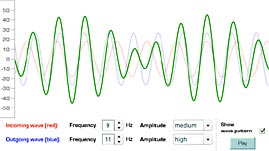Teachers' Domain - Digital Media for the Classroom and Professional Development
User: Preview

Source: University of Southern California, College of Letters, Arts and Sciences, Department of Physics and Astronomy
In this interactive activity adapted from the University of Southern California, learn about standing wave patterns known as Chladni figures. Sand is sprinkled on the surface of a metal plate, and then the plate is forced into resonance vibrations by a sound produced at one of its natural frequencies. Observe how the vibrations produce standing wave patterns in the plate, which become visible as the sand settles into the nodal lines. Different patterns are seen at the different harmonic frequencies of the plate. An animated tutorial illustrates the concept of wave interference and how standing wave patterns form.
When an object vibrates at one of its natural frequencies (a rate of vibration at which it naturally tends to move), standing wave patterns are formed within the object. These patterns are the result of wave interference, which occurs at the meeting of two waves traveling within the same medium in different directions. The resulting disturbance within the material at the point where the waves meet is the net effect of the two waves. At certain points in the material, the waves cancel each other out through destructive interference and there is no net disturbance. These points are called nodes, or nodal points. Around the nodes, the waves constructively interfere; the points with the greatest disturbance are called antinodes, or anti-nodal points.
For example, imagine a rope attached at one end to a fixed point. If you hold the free end of the rope and move it up and down, you create waves. You can force the rope to vibrate at different frequencies by changing the rate at which you shake it. At certain frequencies (the natural frequencies), rather than seeing waves that propagate along the rope, you would see parts of the rope stand still. This happens because your movement introduces waves that travel down the rope, but there are also reflected waves that travel in the other direction up the rope that create interference. The points where the rope is standing still are the nodes; around the nodes, the rope fluctuates up and down.
It is only when an object vibrates at a natural (also known as harmonic) frequency that resonance, which creates large amplitudes of vibration with minimal energy input, and standing wave patterns can be achieved. At other frequencies, the interference does not produce a regular pattern. Standing wave patterns can be seen in the figures formed on Chladni plates, named after Ernst Chladni, a German physicist who studied sound. He observed that sand sprinkled on a plate that is forced to vibrate at its harmonic frequencies displays clear patterns. As the plate vibrates, the sand bounces around until it reaches a place that is not moving—along the nodal points. However, when the plate vibrates at other frequencies that do not produce standing wave patterns, the sand continues to tumble about and does not fall into distinguishable figures.
 Loading Standards
Loading Standards Teachers' Domain is proud to be a Pathways portal to the National Science Digital Library.
Teachers' Domain is proud to be a Pathways portal to the National Science Digital Library.
